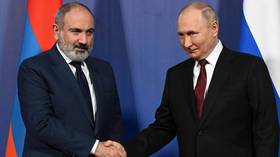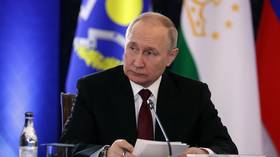Kremlin explains outcome of disagreement with Armenia

Yerevan’s partial rejection of a Collective Security Treaty Organization (CSTO) plan of action doesn’t mean Armenia will leave the bloc, Kremlin spokesman Dmitry Peskov said on Wednesday.
“Of course, it will remain,” Peskov told journalists, adding that the summit in Yerevan “once again confirmed the relevance of this format, the relevance and viability of the CSTO,” even if there were disagreements among the members.
Armenian Prime Minister Nikol Pashinyan had asked the CSTO to speed up political and diplomatic engagement to ensure the “unconditional withdrawal” of Azerbaijani troops from his country’s territory. About 41 square kilometers of Armenia proper have been under Azeri control since an incident in May 2021.
“There were 17 proposed measures. We reached consensus on 15. Two of them were sent back for improvement,” Pashinyan said in a statement ahead of his meeting with Russian President Vladimir Putin on Wednesday. Peskov had described the two points as “nuances” being worked out.
Putin said that Russia and Armenia had discussed the “settlement” of the conflict with Azerbaijan and “unblocking transport arteries,” among other issues.
Established in 1992, the CSTO currently includes Russia, Armenia, Belarus, Kazakhstan, Kyrgyzstan and Tajikistan. Ever since the visit of US House Speaker Nancy Pelosi in September, Pashinyan has complained that the bloc has not done enough to support Armenia in its ongoing conflict with neighboring Azerbaijan over Nagorno Karabakh and other border disputes.
Meanwhile, Putin has highlighted the CSTO’s effective intervention in stopping the unrest in Kazakhstan in January. President Kassym-Jomart Tokayev blamed the riots, which ostensibly began over fuel price hikes, on malign foreign influences seeking to infiltrate the Central Asian nation.
All of the participants in the Yerevan summit have agreed to Moscow’s proposal to strengthen the CSTO peacekeeping force with modern weapons and military equipment.













